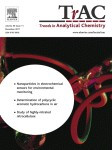Krizkova S, Zitka O, Adam V, Kizek R, Masarik M, Stiborova M, Eckschlager T, Chavis GJ. TrAC. 2011, Volume 30, Issue 11, December 2011, Pages 1819–183. IF: 6.602

Department of Paediatric Haematology and Oncology
Abstract
Matrix metalloproteinases (MMPs) are involved in many physiological and pathological processes. Due to their ability to cleave and to remodel components of surrounding tissues, MMPs may affect cell migration, differentiation, growth, inflammatory processes, neovascularization, wound healing, apoptosis, the uterine cycle and many other actions within the body, including those needed for tumorigenesis and other diseases. MMPs can therefore be used as potential markers for detecting various cancers, neurodegenerative, and immune and cardiovascular diseases. Numerous MMP assays were developed for clinical and research purposes, but far more attention has been devoted to understanding their biological functions. Due to differences in methodology, results obtained in various laboratory settings are difficult to compare because of the lack of standards and analytical methods of validation. Limits of detection of particular methods used for identifying MMPs are also disputable. Enzymatic, immunochemical and fluorimetric methods are particularly suitable for clinical use. In-vivoimaging methods offer many potential advantages in cancer research and diagnostics. Other methods are subject to investigation [e.g., phage display, multiple-enzyme/multiple-reagent assay system (MEMRAS) and activity-based profiling].
-mk-